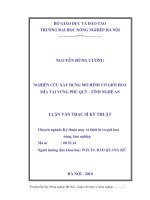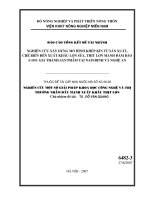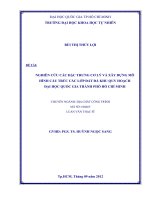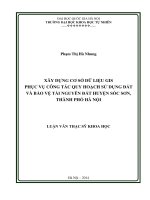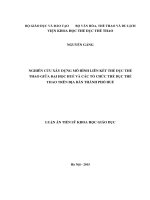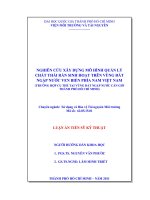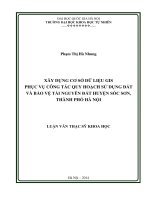Nghiên cứu xây dựng mô hình thành phố ảo phục vụ công tác quy hoạch đô thị tt tiếng anh
Bạn đang xem bản rút gọn của tài liệu. Xem và tải ngay bản đầy đủ của tài liệu tại đây (1.09 MB, 27 trang )
MINISTRY OF EDUCATION AND TRAINING
UNIVERSITY OF MINING AND GEOLOGY
MAI VAN SY
RESEARCH ON BUILDING A VIRTUAL CITY MODEL
FOR URBAN PLANNING
SUMMARY OF DOCTOR THESIS
Ha noi, 2019
The work was completed at: Department of Cartography, Faculty of
Geodesy - Map and Land Management, University of Mining - Geology
Science instructor:
Associate Professor / Doctor. Nguyen Truong Xuan
Reviewer 1: Associate Professor / Doctor. Tran Dinh Tri
Reviewer 2: Doctor. Nguyen Phi Son
Reviewer 3: Associate Professor / Doctor. Pham Viet Hoa
The dissertation will be presented and reviewed before the Assessment
Council of University-level thesis at the University of Mining and Geology at ...
.. hours on ... month ... year 2019
The thesis can be referred at the library: National Library, Hanoi or the
University of Mining and Geology library
INTRODUCTION
1. The urgency of the theme
As we know urban planning is the organization and construction of urban space
for urban development plans and programs of all levels. Urban planning is called
urban construction planning. Urban construction planning is a technical, social and
humanities science, an art of organizing living space for cities and urban areas. Urban
spaces, technical infrastructure works, urban social infrastructure works need to be
planned in accordance with the overall development of socio-economic-environment,
security - national defense. Urban planning and management must satisfy the total
requirements of design, spatial structure planning, ecological, economic and social
environments. All need a multidimensional environment, namely real 3D space or 4D
space (to consider the change over time). The implementation of urban planning and
urban design in the 3D environment is a great leap forward in technology to replace
the traditional GIS 2D urban planning method, which has great significance for urban
managers and designers in the current period.
The study and application of 3D map model to represent the land surface only
stops at simulating terrain, geography, rendering and assigning simple attributes
without building and managing the database (Database) of urban objects in 3D model,
there is no standard framework for spatial database and attributes of 3D objects ...
these matters will make the study of 3D model applications in Urban planning in our
country not correspond to its meaning and not meet the actual needs. Therefore,
building a 3D virtual city model based on a unified 3D database of content and
structure will ensure urban planning and management to take a new step in the
construction path of Smart city (SmartCity) where the 3D virtual city model is set up
as a part of the geospatial data infrastructure (SDI).
In the world, the application of 3D virtual city models in urban planning, design
and management, and territorial management has been studied and has become a
modern method.
In Vietnam, some scientists have begun to study the application of digital
mapping, GIS and information technology... to build 3D models for some areas.
However, due to the large workload, many technical problems still encountered and
1
3D data standards have not been unified, so far, the development of 3D virtual city
models still has faced many issues to be studied. In particular, the systematic research
and giving the scientific foundation and the process of building 3D virtual city models
for urban planning and management need to be implemented.
Therefore, the study of scientific basis as well as the application and
development of appropriate techniques, tools and methods to build 3D virtual city
models for urban planning and management of the thesis's theme is highly necessary,
scientific and practical.
2. Research objectives
Establishing scientific basis and process of building 3D virtual city model for
urban planning and management, proved by experiment in Kien Thuy industrial and
urban area, Hai Phong city.
3. Research object
According to the theme research goal, the object of study is 3D virtual city
model.
4. Research Methodology
method of synthesizing materials: Collecting and researching topics already
studied at home and abroad, on the Internet, books, newspapers and magazines related
to 3D models and urban planning. Thereby, assess, analyze, classify documents by
origin, type, time, author, language ... into the types of main documents, reference
documents, legal documents, and selectively inherit the results which have been
studied.
Modeling method: Method of map modeling, image modeling, GIS modeling,
structure modeling for digital data ....
GIS method: Serving database construction and geospatial analysis
Informatics method: Serving the development of application modules
Method of model presentation: Denotation method by digital map, Denotation
method by static, dynamic 3D model.
Experimental method: Conducting experiments in Kien Thuy industrial and
urban area, Hai Phong city to prove the research results of the thesis.
Expert method: Through workshops, suggestions, getting ideas from experts,
scientists in the field of urban planning, in the field of map surveying and information
2
technology.
5. The scientific and practical significance of the topic
Scientific significance
- The thesis has studied and systematically summarized the scientific basis for
building 3D virtual city model for urban planning and management. Therefore, the
research results of the thesis will help to clarify the scientific basis of 3D virtual city
technology and make sense in creating a premise for the construction and development
of intelligent city data model SmartCity.
Practical significance:
- 3D virtual city model built is valuable information for planners and project
managers of Kien Thuy industrial zone in Hai Phong city.
- Methods and processes researched can be developed to be applied in urban
planning and management in our country.
6. New points of the topic
- Proposing 3D virtual city database including content, data structure, detailed
level to apply in urban planning and management in our country.
- Proposing appropriate technology process in building and exploiting 3D
virtual city model for urban planning and management.
7. Protection of Arguments
Point 1: The proposed 3D virtual city construction database is fully responsive
to perspective presentation, providing creative and intuitive urban spatial information,
ensure analysis and support decision making in urban planning and management.
Point 2: The proposed technological process is in line with the requirements of
building a 3D virtual city for urban planning and management.
8. Document base of the thesis
The thesis is built on the basis: Systematically summarize the scientific basis to
build 3D virtual city model for urban planning and management and create a premise
for building and developing SmartCity smart city data models; articles and scientific
research works of domestic and foreign authors published in specialized journals.
9. The volume and structure of the thesis
The
thesis
consists
of
the
introduction,
3
3
chapters,
conclusions,
recommendations and references. The entire content of the thesis is presented in 133
pages of A4 paper, including 6 tables and 70 figures.
4
CHAPTER 1
OVERVIEW OF RESEARCH ISSUES
1.1. Overview of urban planning and management in our country
1.1.1. Overview of spatial planning and urban planning
The demand for economic development in the context of competition and
conflicts for space exploitation and use in Vietnam is increasing. Therefore, the
application of space planning has become an urgent practical need in general and
unified state management for Vietnam in the coming time.
It can be said that space planning and spatial integrated management are still
new issues for not only managers and policy makers, but also for scientists and
planners in Vietnam.
There are some planning levels as follows:
- General planning
- Zoning planning
- Detailed planning
1.1.2. Requirements of urban planning
1.1.2.1. Content of urban planning
Urban planning is the organization of living space for people in cities and urban
areas, the art of arrangement and organizing functional spaces, establishing
architectural forms in urban areas on the basis of investigating, analyzing, evaluating,
forecasting, estimating the development, characteristics, roles and position in the
relationship of regions, needs and resources of urban development, to concretize
development strategies and policies and minimize harmful impacts arising in the
process of urbanization, making the most of all resources and towards sustainable
development. It is possible to see the indispensable importance of map products (2D)
in planning in general and urban planning in particular. The quality, method and
denotation of urban space on the map model have great significance in the content of
urban planning schemes. This is a highly technical issue with a combination of
planners and map makers, to provide competent authorities in a plan review and at the
same time for agencies, organizations and individuals in the implementation of
5
planning plans in the most effective way.
1.1.2.2. Functions of some types of maps in planning projects
Topographic maps for the elaboration of urban planning schemes built and
issued by state management agencies on maps or by surveying and measuring
agencies, ensuring the prescribed quality and technical requirements about measuring
map product. The information and data of topographic maps must meet the
requirements for urban planning in conformity with each type of urban planning
scheme. In case the topographic map is not suitable for the current situation at the time
of planning, the supplemental survey and measurement and adjustment are carried out.
1.1.3. Current situation of urban planning and urban management in our
country
From the problems raised and the requirements of urban planning practices, the
trend of applying 3D technology to spatial modeling has brought not only for many
sectors but also for urban construction planning a special importance.
In the past, urban design, planning and management were often carried out on
the basis of 2D maps and in addition GIS 2D. These types of maps do not represent
three-dimensional space of urban areas and are difficult to understand if we are not
professionals. With the development of information technology and related graphics
technologies, advanced 3D technology through the use of 3D virtual city models has
overcome the disadvantages of 2D technology. The 3D virtual city models allow
planners and the public to understand complex urban spaces and understand the impact
of future developments. Such 3D models not only help urban planners perform
advanced analysis, planning and decision making, but also help to strengthen
transparency in planning by effectively providing planning information to community.
with the community. Currently, 3D technology in general, 3D virtual city model in
particular is being researched and widely applied in urban design, planning and
management in developed countries and initially in our country. This once again
confirms the urgency of the thesis topic.
1.2. Overview of the situation of 3D model application research in urban
planning and management in the world
Currently, in the world, 3D models applied in urban planning and management
have been interested and studied in many countries such as Australia, Japan, Germany,
6
England, China, Taiwan, etc. [84] , [69], [58], [43], [59]. Right from the beginning of
the history of cartography development, mapmakers discovered many methods of
modeling the earth's surface on the map plane. With 3D models, cartographers have
modeled the territorial surface visually and vividly, making the process of territorial
awareness faster and more intuitively. 3D models have been used in many different
areas such as hydrology, transport, planning, military, ... [43], [44], [68]. In particular,
the idea of applying 3D technology in planning work was introduced by Saarinen in
the first half of the 20th century [40]. However, only when information technology
developed, was the realization of Saarinen's idea possible [36], [83].
1.3. Overview of research situation in Vietnam
In Vietnam, in the last few years, 3D GIS and three-dimensional maps have
also been studied. It is possible to list here some typical studies such as: the works of
"representation of three-dimensional map and application" [16]. The study focused on
three-dimensional map representation methods, thereby showing that the network of
irregular triangles (TIN) is suitable for representing three-dimensional maps. This
study focused on the basic concepts, mathematical foundations of three-dimensional
topographic maps, thereby, propose to test methods of constructing and representing
three-dimensional topographic maps based on technology ArcGIS of ESRI (USA). In
2008, in Hanoi, the Ministry of Construction organized a seminar on "Seminar on
application of geographic information systems (GIS) in urban development", which
emphasized the important role and applicability of 3D GIS for the city planning and
architecture support as well as traffic problems. Currently, in our country, many new
technologies have been applied to collect three-dimensional spatial data such as
sweeping terrain using laser (LiDAR), stereoscopic measurement and drawing,
orthogonal radar, etc. These data are very good input for modeling three-dimensional
maps, but currently these data are newly stored as a text file (text) set of xyz
coordinates, regular grid pattern (grid) ... The natural resources and environment
industry is in need of specific research to apply to observable data objects to build and
manage three-dimensional maps.
1.4. Research orientation of the thesis topic
Through researching and studying the technology development process and
research projects in the world and in our country, we realize that: Some developed
7
countries in the world have initially researched and successfully applied 3D virtual city
models in urban planning and management. The content of their research focuses on
three issues: techniques of building 3D virtual city models, developing tools (hardware
and software) and building information systems based on virtual city models and link
with e-government model.
Therefore, with the wish to contribute to the early application of 3D virtual city
model in urban planning and management in our country, the researcher has oriented
the research as follows: On the basis of reference and inheriting a number of research
achievements in the world and some initial research results in our country, will
systematically study the scientific basis of technology, including a list of content and
structure, the detailed level of 3D virtual city model, proposing the process of building
3D virtual city model, and studying the experimental application of building 3D model
of Kien Thuy industrial urban area with area about 912,83ha in Hai Phong City to
verify.
Conclusion chapter 1
So far, the view of urban planning and management has changed significantly.
Although in the process of urban planning and management in the past, only a few
organizations and experts work in their own fields, but the current planning and
management are increasingly concerned by participation and cooperation among
different groups of stakeholders and by closer integration in the areas of expertise.
There have been many special scientific research projects, not building 3D
virtual city model based on 3D database for the orientation of spatial planning, the
concept of virtual city model in the form of New space simulation has been
approached by a number of authors in a number of research projects, building 3D
virtual city model based on 3D database as an approach from 2D GIS to 3D GIS
receives very little research in Vietnam.
On the basis of reference and inheritance of some research achievements in the
world and some initial research results in our country, there will be a systematic study
of the scientific basis of technology, which proposes table of content, structure,
detailed level of 3D virtual city model, the process of building 3D virtual city model.
8
CHAPTER 2
SCIENTIFIC BASIS FOR BUILDING A 3D VIRTUAL CITY
FOR URBAN PLANNING AND MANAGEMENT
2.1. 3D virtual city
Concept of 3D virtual city
3D virtual city model (3D geovirtual abbreviated as GeoVEs) is understood to
be the digital representation of real cities, can see the city at any point and explore
interaction by users on the computer based on geospatial data. This definition
emphasizes three important aspects:
1. 3D virtual city model provides an interactive media, a virtual space, allowing
users to explore truly miniature urban environment in modeling.
2. 3D virtual city model consists of three basic components: Geospatial data,
visual systems that transform data into interactive 3D models, software and computer
hardware.
3. The 3D virtual city model is geographic space, i.e. the real position of any
object described in the data model and is displayed as a 3D object.
2.2. Content Spatial data of 3D city model
2.2.1. 3D geographic background group data
* Digital Elevation Model (DEM)
* Digital Terrain Model (DTM)
* Digital surface model (Digital Surface Model - DSM)
* Geographic background data from large scale topographic maps
* Materials without photos
* Ground image data
2.2.2. Geological group data in urban space
2.2.2.1. Groups of geological objects
Objects located right on the road surface topography such as rivers, streams,
roads, points like control points can be described by 2D or 3D data. For 3D data they
can be represented independently and accurately in their 3D environment, regardless
of the terrain surface data as their background.
9
On 3D maps, details of urban areas, houses and blocks are a group of objects
which are very interested in how to express. This group is quite diverse in geometric
structure. They can be detailed in real 3D models, each with X, Y, H values or
generalized at different levels depending on the level of detail shown.
2.2.2.2. Building houses and construction works on the basis of 3D terrain.
On the 3D terrain map, houses can be represented by foot contour polygon with
house height and fire resistance properties. This height is obtained from the results of
the last-echo lidar data as mentioned above. At first, the home polygon layer is
overlaid on the DTM face with the Base height tool.
2.2.2.3. Show other objects on the map
- Hydrology and related objects
- Traffic and related objects
- Economic and social cultural objects
- Power lines and information lines
- Soil shape and soil
- Plants:
- Note:
2.2.3. Integration from other data sources
2.2.3.1. Data integration of areas to be protected
Data on nature reserves or other protected areas are stored as geographic vector
data. Attribute tables contain information about the protection status, the name of the
protected area, the date specified, the legal basis for the assignment .... Figure 2.2
shows three methods used to visualize data on protected areas in a 3D virtual city
model.
2.2.3.2. Integrated water areas
Land use data from digital cadastral maps has been used to select water area
and combine them into CityGML Water Objects which are integrated into 3D virtual
city models. Therefore, the selected features have been converted and written to
CityGML file.
2.2.3.3. Integrating plans from urban planning
Several planning processes have taken place and are still ongoing in the area we
study. So far, three different types of plans have been tested: master plans,
10
development plans and construction plans.
2.2.3.4. Integrated master plans
The main issues in the planning process are the concept of height and
construction density of planning proposals, master planning and planning versions
which have been continuously integrated into the 3D Land Information System to
provide visual simulations during the planning process.
Figure 2.2: Integration method
Figure 2.3: Extrusion-based modeling method
for geographic vector data
used to represent overall diagrams through
Block models and terrain surface structures
Figure 2.4: 3D modeling approach to create
Figure 2.5: Illustrate modeling methods
planning representations as 3D models
based on CityGML
2.2.3.5. Integrated planning diagrams
The second type of planning to be tested is planning schemes. Planning
schemes are legally binding planning documents, which define future land use as well
as construction density and construction objects.
2.2.3.6. Integrated construction projects
It is necessary to edit topology data and create a data set of building block
feature. They are prepared by adding attributes that keep height information and export
to SketchUp. The main plot plans and drawings, which must be prepared for
construction permission, will be used as an alternative to the 3D model.
2.2.3.7. Integrate more information through attributes, impacts and annotations
The methods presented so far focus on integrating visual representations of
geodata and planning into 3D city models. In many cases, these visual representations
11
can be considered interfaces for more spatial information.
2.3. Study proposed 3D virtual city database
Database for 3D model is much more complicated than 2D database. This is a
new issue in Vietnam, without any standards or regulations issued by the state. The
construction of 3D virtual city model based on one standard framework for structured
3D databases is required.
2.3.1. Space reference frame of data
According to the current regulations on geodesic products in the territory of
Vietnam, it is necessary to unify to use VN2000 coordinate system for maps:
topography, cadastral, planning, current status ... According to the current regulations
on surveying and mapping products in the territory of Vietnam, the VN2000 system
coordinate must be used for maps: topography, cadastral, planning, current status ...
2.3.2. 3D object graphics structure
Any object is built based on: points, lines, planes and finally using 3D
constructing to create objects. After having a 3D model, the next task is to assign a
surface image, fill, shadow, and pattern, in which the surface piece image is related to
the detail level of the image (LoD).
2.3.3. Detailed levels in 3D virtual city model
The process of building a 3D map can be divided into two main steps that are
similar to making a maquette, at first creating a frame, then covering the color layers
and adding other objects.
2.3.4. Propose level of detail in 3D virtual city model
Thus, based on the above analysis, it can be seen that in reality the LoD concept
is used to express the smoothness of 3D object surface. However, LoD is just one of
the aspects to consider when acquiring a 3D virtual city model, because from a
geometric point of view, there are many variations of models in each LoD.
So, 3 levels of LoD1, LoD2, LoD3 which will be used in urban space
simulation are the most suitable, ensuring the functions as well as effectively serve the
problem of analyzing virtual space.
12
Figure 2.12: Detailed levels (LoD) in 3D virtual city model
2.3.5. Recommend content and data structure
2.3.5.1. Analyze the content components of 3D virtual city database
In 2D vector data, there are 3 main types of objects: points, lines, regions, and
for 3D data, there are 5 types: points, lines, regions, faces, blocks. All these objects are
attached to the DEM surface. The structure of 3D space model includes DEM
background, graphic data of geographic objects, attribute data associated with the
graphic data of the object and all are displayed in 3D environment on principle map.
Table 2.1: Regulations on accuracy of 3D object height
2.3.5.2. Propose a list of content and structure of data
The thesis proposes the content and structure of 3D virtual city database as follows:
13
Figure 2.13: Structure diagram of 3D virtual city database model
2.4. Proposing the process of building 3D virtual city for urban planning
and management
2.4.1. General Process
There are three main design and construction elements in the process of
building 3D virtual city models. First of all, it is necessary to set up and build a
geographic database with the feature of the designed data set. Secondly, set up 3D
geometry model based on previously built data set. Finally, the analysis process to
display the final results in 3D environment.
2D
database
Update
geographic
coordinates
Building
geographic
database
Display 3D
model
results
Analyze,
process
Set 3D
geometry
model
Design 3D
virtual city
model
Figure 2.23: Process of processing and forming 3D model
2.4.2. The process of building 3D maps from high-resolution remote
sensing images
The process of building 3D virtual city model from high-resolution remote
sensing image basically consists of 4 steps: stereoscopic image measurement;
processing orthogonal images; extract pictures of foundations of buildings, works and
build 3D city models.
14
2.4.3. Proposing the process of building 3D virtual city model for urban
planning
In fact, the 2.24 process allows building 3D virtual city model (3DCM), but not
yet a 3D model for detailed planning work. The 3D virtual city model established from
ultra-high and high resolution remote sensing will provide a state-of-the-art model,
based on that, combined with planning 3D models, will create a 3D virtual city model
for urban planning.
Figure 2.26. Workflow diagram for 3D city modelling
Conclusion Chapter 2:
The content of the chapter has studied and systematically summarized the
scientific basis for building a 3D virtual city model for urban planning and
management.
Analyzed the content objects when modeling the urban real space, summarized
and classified by groups based on the nature and characteristics of urban space,
thereby proposing the content framework of objects in urban space. The proposed
content framework is based on the inheritance of international standards (CityGML of
OGC), developed based on Vietnam's current 2D geographic technical standards
15
(QCVN11: 2008 / BTNMT; QCVN04: 2009 / BTNMT; QCVN42: 2012 / BTNMT).
The standard framework of 10 data groups has been proposed in accordance with
urban planning and management purposes.
Developed a 3D city database framework with the proposed data list of each
data group, structure model for each data layer, detailed level in the demonstration
(LoD), in accordance with Vietnam urban planning requirements. Each object
managed in the database ensures the establishment of 3D models of urban areas based
on each spatial attribute, quantitative attributes of the objects, thereby ensuring the
quantitative analysis of the Planning math problem, like a GIS 3D.
A complete technological process has been proposed to build a 3D virtual city
model for urban planning and management.
CHAPTER 3
EXPERIENCE TO BUILD THE MODEL OF A 3D VIRTUAL CITY
KIEN THUY URBAN INDUSTRIAL PARK, HAI PHONG CITY
3.1. Introduce the study area
Figure 3.1: The study area
3.2. Building 3D virtual city model of test area
3.2.1. Selecting software
Based on the results of the survey of existing software and experience, Skyline
was chosen as a software to test and introduce 3D model products in this experiment
because this is the software package for 3D space application, providing visual display
solution, terrain analysis, planning in 3D space.
Skyline software has modules such as TerraBuilder, TerraExplorer (Pro, Plus,
Viewer), TerraGate, Web has structure as follows:
16
Figure 3.2: Operation structure of Skyline
3.2.2.2. Prepare a picture map and digital model of the height of the study area
UAV images obtained after shooting will be processed by Pix4D mapper
software. The result is a UAV picture map with a 5cm and DSM 10 cm resolution.
Figure 3.5: Digital Surface Model (DSM)
Figure 3.4: Picture map of the study area
established from UAV image
3.2.2.3. Building a geographic information database with a scale of 1: 2000
UAV image material combined with materials on specialized software, image
maps, topographic maps and geographic databases at 1: 2,000 scale of experimental
areas are completed.
3.2.3. Build 3D virtual city model
In order to build a 3D city model from a 2D database source created above, it is
necessary to classify objects according to CityGML standards.
17
Figure 3.6: Topographic map with scale 1: 2000
Figure 3.8: Terrain simulation results
3.3. Integrating planning solutions
In order to integrate planning solutions into 3DCM, the first step is to digitize
2D planning maps, to convert objects to DEM backgrounds, to assign elevations and
LoD levels and finally integrate plans into the 3DCM city model.
3.3.1. Digitize plans
Unlike geographic data, most plans and planning solutions are not
georeferenced and cannot be directly integrated into the 3D city model.
Therefore, at first, it is necessary to encode the planning map geography and
transfer the spatial reference frame to VN2000 before the model integrated into
3DCM.
Figure 3.9: Digitized planning solution on ArcGIS software
3.3.2. Standardize 3D space data planning plans
3D models planning schemes are classified into groups (buildings, moving
objects, and plant objects), and the building's height on the ground and the base height
assigned into the height of DEM at the object position as attribute in GIS environment.
- Prepare software
- Prepare 3D notation library
- Geophysics model
18
- Houses and blocks
- Urban technical infrastructure works
- Tree symbols
- Geophysics model photos and Level of Detail - LoD
3.3.3. Integrate planning solution on 3D virtual city model
3.3.3.1. Construction works (high buildings, low buildings, workshop)
The key issue in the planning process is the concept of height and construction
density of proposed plans. The master plan and the plan version have been
continuously integrated into the 3DCM Model to provide simulation images during the
planning process.
3.3.3.2. Roads (main axis, dyke road, pavement)
The traffic object layers, dyke, pavement after being digitized on ArcGIS
software into database will be integrated into 3D city model. On 3D software, there are
functions to import and present these object layers. The software allows to select the
color or structure of the object.
3.3.3.3. Water system
From database, the water surface is converted into the City Model. The
software allows to select the fill color or water effect.
3.3.3.5. Dynamic objects
For 3D city model to be livelier and more realistic, it is necessary to add
dynamic 3D models such as: Cars, trams, ...
3.3.3.6. Power line
The software allows simulation of power lines.
3.3.3.7. Drainage works
The software allows simulation of water supply and drainage works. Water
supply and drainage works are often underground, under the surface of DEM.
3.4. Develop a number of supporting software "tools"
On Skyline software system, there are several spatial analysis tools: Vision
analysis, Sun shadow analysis ..., to solve planning problems, it is necessary to attach
specific planning criteria, but this software does not have. To solve these problems, it
is necessary to build some supporting software "tools" on Skyline. In this thesis,
researcher has deeply studied the Skyline Software set and developed more tools to
19
support urban planning.
3.4.1. Check the ratio of minimum land to plant trees
It is very important to check whether the land use map is in accordance with the
standard or not. Previously, this check was done manually and when there was a
change, it had to be recalculated from the beginning. In 3DCM, we have built a tool to
check the land use map in general and in particular the percentage of land to plant
trees.
3.4.2. Check building design
Objects of houses and blocks are designed with detailed fields including:
Figure 3.29: Properties of houses and blocks
Figure 3.30: Check building design
In urban planning, it is necessary to adhere to the principles of urban design.
3.4.3. Regulations on the setback space
The same as standard of an urban planning scheme also stipulates the setback
space of the building adjacent to the urban traffic axes.
3.4.4. Regulations on the minimum distance between blocks
According to the standards of an urban planning scheme, the stipulation of
minimum distance between blocks is mandatory, the planning design must always
ensure this criterion. 3D model provides a utility tool to control this indicator.
3.4.5. Support for urban design testing
In the thesis, we have built a tool to allow urban design testing to check the
requirements on distance between blocks, the project setback, construction density ...
If any planned object does not meet the requirements on the system will list it for the
urban designer to re-examine the design plan.
3.5. Introducing some application results of 3D virtual city model in
experimental area
3.5.1. Demonstration of model views
20
3D software allows users to build scenarios including effects: geographic
location, animation of moving objects, simulating the process of constructing buildings
... for showing and presentation of planning plans.
3.5.2. Analysis and Simulation
For urban designers, the most important application based on 3D city models is
visual analysis. In 3D virtual dynamic environment, through the calculation of vision
through simulation of model vision and visual analysis for areas, quantify geometry
relations which can be seen or helped by Application software tools to make the design
process more practical and scientific.
- Simulation of visual space
- Visual analysis and visibility calculations.
- Analysis of urban space physical quality
3.5.3. Decision-making support
A support system that determines the design process is very complex, and it
engages in all of the above aspects, physical quality, image quality, and functional
quality of space. In general, some analytical functions are needed to make decisions. In
a spatial decision support system (SDSS), to match the design process, all necessary
analytical functions should be integrated. Visual images from computers can change
the way we think and how we work. For architects and planners, it can change the
design way. The ability to visualize urban structural changes and experience changes
in their actual context allows planners and designers to evaluate, select, replace
quicker, more detailed, and low-cost through more traditional analysis.
Conclusion Chapter 3:
In Chapter 3, researcher has completed experiments to build 3D virtual city
model of Kien Thuy industrial urban area in Hai Phong city based on using UAV
technology with specialized software like Pix4D mapper and Agisoft software.
Photoscan and Skyline ... In addition, researcher used the standardized language c #
with interface in Vietnamese in Skyline, writing 5 more application modules to
support urban planning and management. Experimental results have initially proved
the goals and proposals of the project.
21
CONCLUSIONS AND RECOMMENDATIONS
Conclusion
The research results of this thesis developed a 3D virtual city model to a new
level, in addition to the ability to perform, simulate, and visualize, but also capable of
analyzing spatial problems and management of 3D objects according to structure,
ensuring objectives to support urban planning and management. Thereby, through
experiment research in Kien Thuy industrial park, Hai Phong to prove the
effectiveness in supporting the management of 3D map model in general and 3D city
virtual model in particular. The research results of the thesis include:
1.Through an overview study of issues of building 3D models for urban
planning and management, a comprehensive and sufficient introduction of urban
planning issues and the necessity of maps forms in general and 3D map models in
particular in construction planning projects. Methods to build 3D models, trends and
situation of 3D model research and application in the country and the world, thereby
serving as a basis for the selection of technological solutions in the construction of the
virtual city of the thesis.
2. The thesis has researched and applied advanced technologies of map
measurement in the process of building 3D data model. Technological solutions for
UAV in building 2D geographic background data, image graphs, DTM, topographic
map data ... from there are input data for 3D models. This demonstrates that the
technologies of map surveying fully meet the requirements for data acquisition in 3D
virtual city model building.
3. The dissertation has analyzed content objects when modeling the real space
of urban areas, summarizing and classifying them based on the nature and
characteristics of urban space, thereby propose content frame of objects in urban
space. The proposed content framework is based on the inheritance of international
standards (CityGML of OGC), developed based on Vietnam's current 2D geographic
technical standards (QCVN11: 2008 / BTNMT; QCVN04: 2009 / BTNMT; QCVN42:
2012 / BTNMT). The standard framework of 10 data groups has been proposed in
accordance with urban planning and management purposes.
4. In the dissertation, the 3D city database framework has been developed with
22
the proposed data list of each data group, the structure model for each data layer, the
level of detail in the demonstration (LoD), in accordance with Vietnam urban planning
requirement. Each object managed in the database ensures the establishment of 3D
models of urban areas based on each spatial attribute, quantitative attributes of the
objects, thereby ensuring the quantitative analysis of the Planning math problem, like a
3D GIS.
5. From the 3D virtual city database model, the thesis has developed
applications for quantitative analysis of space in urban areas. The 3D model for urban
planning and management is applicable to quantitative analysis according to urban
planning standards, this is a new issue established to support the examination of
planning projects and decision-making in the process of urban management according
to planning.
6. The thesis has proposed a complete technological process for building 3D
virtual city models for urban planning and management.
7. Experimental results of building 3D virtual city model Kien Thuy industrial
urban area (with an area of 912.83 ha) in Hai Phong City has initially proved the
proposals and ability to apply 3D virtual city model in urban planning and
management in our country.
The scientific basis and experiment results of the thesis on building a virtual
city model 3D will be the basis to effectively support the planning and urban
management not only for the study area but also as a foundation to develop and
multiply the model of virtual city application in development planning of urban areas
and industrial parks in the country.
Recommendation
Currently in our country, the study of 3D model in general, 3D virtual city
model in urban planning and management in particular is only the initial steps. In
order to effectively implement research and application in our country, we need to
focus on some of the following issues:
1. Develop and issue a National technical standard on 3D databases, at first for
Vietnamese cities.
2. Manage integrated GeodataBase 3D urban planning projects in city databases
to ensure management and support of urban government decision making.
23
